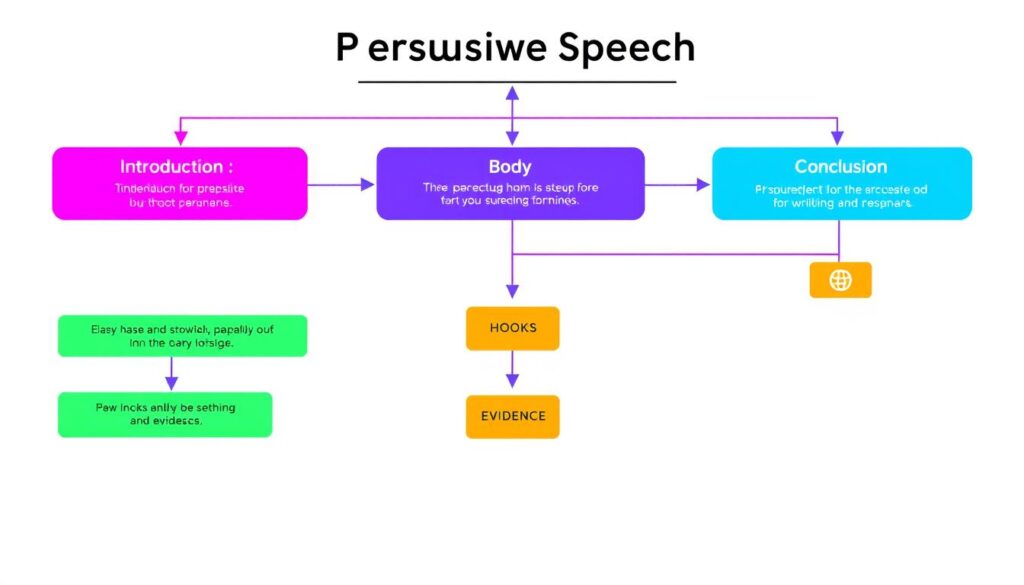In today’s fast world, knowing how to write and speak persuasively is key. It’s crucial for business leaders, politicians, and anyone wanting to make a difference. This article will teach you the basics and advanced techniques to become a skilled persuasive speech writer. You’ll learn to engage your audience and bring about change.

Key Takeaways
- Discover the psychology behind effective persuasion
- Learn the core elements of impactful speeches
- Understand the power of emotional connection in persuasive writing
- Craft a compelling speech structure that engages your audience
- Master the art of persuasive language and rhetorical devices
Understanding the Fundamentals of Persuasive Speech Writing
Making a persuasive speech needs a deep grasp of communication psychology. By exploring persuasion psychology, you can learn to engage your audience and motivate them to act.
The Psychology Behind Persuasion
Great persuasive speeches connect with our feelings, beliefs, and choices. They use emotional appeal through stories and images to bond with the audience. They also keep listeners engaged with interactive elements and rhetorical tricks.
Core Elements of Effective Speeches
A persuasive speech has a clear speech structure. It starts strong, has a well-organized middle, and ends with a lasting impression. Speakers use rhetorical devices like metaphors to make their words more impactful.
The Power of Emotional Connection
Logic is key, but emotions are just as important. Effective speakers know how to touch their audience’s hearts. They create feelings of empathy, inspiration, or unity.
“The most powerful way to connect with your audience is to speak to their hearts, not just their minds.”
By mastering persuasive speech writing, you can win over your audience. Knowing the basics of persuasion, speech structure, and emotional connection is crucial. It helps you create speeches that truly move your listeners.
Essential Components of a Compelling Speech Structure
Making a persuasive speech is more than just putting words together. You need a structured speech that takes your audience from the start to the end. Let’s look at the main parts of a strong speech structure.
The introduction is your chance to grab your audience’s attention. It should be engaging, clearly state your main point, and show what’s coming next.
The body is where you share your main message. Organize your ideas into clear paragraphs that flow well. Use transitions to help your audience follow your thoughts.
- Start strong to grab your audience’s attention.
- Share your main points clearly and in order.
- Use evidence and examples to back up your arguments.
The conclusion is your last chance to make an impact. Sum up your main points, restate your thesis, and end with something powerful. This could be a call to action or a thought-provoking statement.
“The structure of a speech is as important as the content itself. A well-organized speech can make even the most complex ideas accessible and memorable.”
By focusing on speech organization, you’ll improve your ability to deliver a compelling speech. Your audience will be engaged from start to finish.

Crafting Your Opening Hook: Techniques That Grab Attention
Grabbing your audience’s attention right away is key in a persuasive speech. Skilled speakers use many ways to catch their audience’s interest. They might start with a story or share surprising statistics. These methods keep your audience hooked from start to finish.
Starting With a Story
Storytelling in speeches is incredibly powerful. Starting with a personal story or a story that people can relate to helps connect with your audience. It makes your speech more memorable and impactful. This is because stories touch on our deep love for engaging tales.
Using Statistics and Facts
Using data to support your points can really win over your audience. Adding statistics, research, or interesting facts grabs their attention. It also makes your message more believable. This is great for showing how urgent or important your topic is.
Posing Thought-Provoking Questions
Rhetorical questions are a strong tool for your opening. Asking questions that make your audience think can really get them involved. It’s a great way to stir up feelings or challenge what they believe. This prepares them for a deeper dive into your topic.
The start of your speech is your chance to grab everyone’s attention. By using these techniques, you can create an opening that pulls your audience in. It sets the stage for them to fully engage with what you have to say.
Mastering Persuasive Language and Rhetorical Devices
To win over your audience, you need to use persuasive language and rhetorical techniques. These methods do more than just share facts. They touch on emotions and logic, creating a story that really hits home.
Figurative language, like metaphors and analogies, is very powerful. It makes your message clearer by comparing it to things we already know. For example, metaphors turn complex ideas into pictures we can remember.
Repetition is another key tool. Repeating important phrases makes your message stick in people’s minds. It also adds rhythm and interest to your speech, making it more engaging.
Leveraging Ethos, Pathos, and Logos
The ancient Greeks knew about ethos, pathos, and logos. Ethos is about being credible and trustworthy. Pathos appeals to feelings. Logos uses logic and evidence to back up your points.
Using all three makes your speech strong and effective. Ethos shows you’re an expert, pathos connects with emotions, and logos provides solid arguments.
| Rhetorical Technique | Description | Example |
|---|---|---|
| Metaphor | A figure of speech that compares two unlike things without using “like” or “as” | “The mind is a garden that needs to be tended with care.” |
| Analogy | A comparison between two similar things to help explain a concept | “Learning a new skill is like climbing a mountain – it takes time, effort, and perseverance.” |
| Repetition | The deliberate use of a word or phrase to emphasize a point | “Change is not easy, but change is necessary. Change is the key to our future.” |
Learning rhetorical techniques and figurative language can make your persuasive writing better. It helps you connect with your audience through ethos, pathos, and logos. Use these tools to make your persuasive speech even more powerful.
Building Credibility Through Research and Evidence
In the world of persuasive speech writing, credibility is key. To win over your audience, you need solid research and evidence. This guide will help you create a speech that proves you’re trustworthy and knowledgeable.
Finding Reliable Sources
For a credible speech, use credible sources of information. Look for respected sources in your field. Academic journals, industry publications, and trusted news outlets are great places to find research methods and evidence-based arguments. Make sure your sources are reliable and accurate to build a strong speech.
Incorporating Expert Opinions
Using the opinions of experts can make your speech more credible. Choose expert opinions that support your main points. Integrate these insights into your speech to strengthen your argument and show your authority.
Using Real-World Examples
Real-world examples and case studies can make your speech more engaging. Look for evidence-based arguments and stories from trusted sources. Pick examples that connect with your audience and highlight the importance of your message.
By using these strategies, you can create a persuasive speech. It will be backed by credible sources, expert testimony, and evidence-based arguments. This will make you a trusted and authoritative speaker, helping you persuade your audience and achieve your goals.

Advanced Techniques in Persuasive Speech Writing
Improving your persuasive speech writing means learning advanced techniques. These techniques grab your audience’s attention and push them to act. Learn about cognitive biases, which are mental shortcuts people use to decide things.
See how framing your arguments can change how people see and accept them. Also, be ready to face counterarguments. This shows you’re knowledgeable and builds trust.
Creating a strong call-to-action is key. It encourages your audience to take action after your speech. This could be signing up for something, supporting a cause, or starting new strategies. Your call-to-action will make a big impression and motivate your listeners to change.
Using these advanced techniques in your speech writing will engage your audience. It will help you overcome objections and lead people to the outcomes you want. Improve your speaking skills and leave a lasting impact on your listeners.
FAQ
What are the key benefits of mastering persuasive speech writing?
Mastering persuasive speech writing boosts your influence and leadership. It also sharpens your communication skills. You can share your message more clearly and connect with your audience deeply.
What are the essential components of a compelling speech structure?
A persuasive speech needs a strong introduction, organized body paragraphs, and a powerful conclusion. It’s important to keep your ideas flowing logically and coherently.
How can I create an attention-grabbing opening for my speech?
To grab your audience’s attention, start with a story, impactful statistics, or a thought-provoking question. These methods engage your audience and set the speech’s tone.
What persuasive language and rhetorical devices can I use to enhance my speech?
Use persuasive language and rhetorical devices like metaphors, analogies, and repetition. Also, strategically apply ethos, pathos, and logos. These techniques connect with your audience emotionally and intellectually.
How can I build credibility through research and evidence?
To increase your speech’s credibility, use solid research and evidence. Find reliable sources, include expert opinions, and use real-world examples. These support your main points.
What advanced techniques can I use to make my speech more persuasive?
For a more persuasive speech, use advanced techniques like cognitive biases and framing arguments. Address counterarguments and create compelling calls-to-action. These strategies motivate your audience and prompt them to act.




